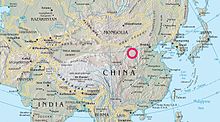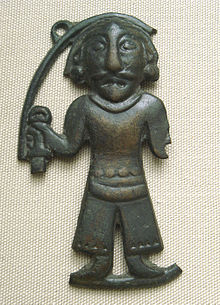Ordos culture
| Paleolithic cultures of China | |
| Paleolithic | |
| Xihoudu culture | 1270,000 BP |
| Ordos culture | 50,000-35,000 BP |
| Xiachuan culture | 24,000-16,000 BP |
| Xiaonanhai culture | 22650-21650 BP |
| Tongliang culture | 24450 ± 850 BP |
| Maomaodong culture | 14600 ± 1200 BP |
| Fulin culture | |
| Kehe culture | |
| Dingsishan culture | |
| Gezidong culture | |
| Miaohoushan culture | |
| Donggutuo culture | |
| Xiaochangliang culture | |
| Shilongtou culture | |
| Shuicheng culture | |
| Shuidonggou culture | |
| Yanbulaq culture | |
| Mesolithic | |
The Ordos culture is an archaeological culture from the Upper Paleolithic to the Bronze Age in the area of the Ordos Plateau in southern Inner Mongolia ( China , around 300 km from modern Beijing ). The population of the Ordos was predominantly East Asian, which is deduced from their skeletal remains and artifacts . Over the centuries, however, numerous influences from people with European characteristics may have acted on them before this land was conquered by the Qin and Han .
Prehistoric people
Old Stone Age
The Ordos culture has been documented since the Upper Paleolithic . The location of their tools suggests Levallois technique in the manufacture of their hoes and stone tools, which are very similar to those found in Zhoukoudian . Presumably the people of the Ordos had a great deal of knowledge in Paleolithic technology, because blades up to 15 cm in length could be excavated.
Fossil human remains of an Ordos man were found in Salawusu and dated between 50,000 and 35,000 BC. To be dated. They show clear Mongolian features, especially the front teeth and occiput .
Neolithic
One of the cultures that populated the Ordos Plateau in the Neolithic is the Zhukaigou culture, which dates back to 2,200 to 1,500 BC. Is dated. Recent genetic studies of human remains found in 327 tombs show that this population was closely related to the Yinniugou, as well as some modern populations, such as the Daur or the Evenks . Archaeological finds from this culture are very similar to those of the older Xiajiadian culture. These are likely to be the beginning of the development of snake pattern designs for weapons and those forms of representation of animal artifacts that later became known as the Ordos style.

The actual Ordos people have been proven for the region of the Ordos Plateau from the 6th to the 2nd century BC. Its predecessor population is unknown, presumably they were Mongols.
Skeletal remains from the Taohongbala tomb were dated between the 6th and 7th centuries BC. Usually they are identified with the Xiongnu bronze culture. They also show clear Mongolian features. In 1979 a similar type of grave was discovered in Hulusitai , near Bayan Nur , dating from the 5th to 4th centuries BC. BC could be dated. The population to which this type goes back is likely to be the only Xiongnu culture that settled on the northern slope of the Yinshan . Numerous bronze artifacts, ceramics and the remains of 27 horse skeletons were found at this site. Another excavation at Guaxianyaozi in 1983 examined 31 graves from the 6th to 5th centuries BC. It also showed clear northern Mongolian characteristics that increased towards the south. In Maoqinggou and Yinniugou , skeletal remains of eastern and northern Mongols from the 7th century were found in 117 graves. Grave goods in the form of weapons were similar to the Chinese style.
Numerous representations of the Ordos people can be found in archaeological finds from Baotou (M63: 22, M63: 23, M84: 5), Etuoke (M1, M6), Xihaokou (M3), under Woertuhao (M3: 1) and Mengjialiang . They tend to portray this people with straight hair.
Saaks and Scythians
From the 6th to the 2nd century BC, the region was populated by equestrian nomads who were later driven out by the Xiongnu. According to Lebedynsky, they were probably the most easterly settled people of the Scythians , who lived here in the immediate vicinity of the Yuezhi , who are mainly known for their skeletal remains and artifacts. Archaeological finds show this people rather European characteristics and can therefore be assigned to the Scythians. The weapons that were found in tombs across the steppe also have a lot in common with those of the Scythians, especially those of the Saka . The Ordos also produced belt buckles, bridles and weapons with images of animals (often in battle scenes). In their "animal style" they are related to the nomadic traditions (such as that of the Scythians), which are represented by Central Asian finds.
Frequent contact with the pre-Han and Han populations during this period led to numerous wars. Their territory at that time is located directly north of the Great Wall of China and in the southern bed of the northernmost loop of the Yellow River .
Relationships
The eastern neighbors of the Ordos could have been identical to the Yuezhi, who, after being defeated by the Xiongnu, migrated to southern Asia to establish Kushana . These were also related to other nomadic tribes in the east, the Donghu ( 東 胡 ), who shared a similar “steppe art” with them, but were apparently Mongols. They may also have been related to the Di (Chinese: 氐; "Western barbarians") mentioned in Chinese annals.
The Ordos region was the place where the legendary beginnings of the Turkic peoples are located.
Conquest by the Xiongnu
In Chinese records the Xiongnu in Ordos first appear in the works Yizhoushu and Classic of Mountains and Seas during the Warring States Period , before the region of Qin and Zhao was conquered. The Ordos is commonly believed to be their country of origin, although it is unclear exactly when the region was conquered. However, according to some archaeological finds, this could have been much earlier than traditionally assumed.
When the Xiongnu under their leader Modun around 160 BC. BC spread south into the Yuezhi Territory, these in turn defeated the Sakas and pushed them back to the Issyk Kul . Probably during this period they also conquered the Ordos region, where they came into direct contact with the Chinese. From there they made numerous devastating attacks on Chinese territory (167, 158, 142 and 129 BC).
The Han dynasty began to fight the Xiongnu under Emperor Han Wudi in the 2nd century BC and settled the Ordos region under the command of Shuofang in 127 BC. Prior to this, the Qin and Zhao command offices had been set up until they were in 209 BC. Were overrun by the Xiongnu.
Artifacts
Important artifacts of the Ordos can be seen in the "Asian Gallery" in the British Museum :
See also
Individual evidence
- ↑ Liqing Ma: The Original Xiongnu, An Archaeological Exploration of the Xiongnu's History and Culture . Inner Mongolia University Press, Hohhot 2005, ISBN 7-81074-796-7 , pp. 196-197.
- ↑ Iaroslav Lebedynsky: Les Nomades . Editions Errance, Paris 2007, p. 131.
- ^ Jacquetta Hawkes , Sir Leonard Woolley , History of Mankind , Volume I. Harper and Row , New York 1963, p. 172.
- ↑ Huang Weiwen: Salawusu Relic . In: Encyclopedia of China. 1st ed.
- ↑ Hal-jing Wang, E. Chang, Da-wei Cai; Quan-chao Zhang, Hui Zhou, Hong Zhu, (1. Ancient DNA Laboratory, Research Center for Chinese Frontier Archeology, Jilin University, Changchun 130012, China: 2. Teaching and Research Center of Chemistry, College of Chemistry, Jilin University, Changchun 130021, China; 3. Macromolecular Laboratory, College of Life Science, Jilin University, Changchun 130023, China): Mitochondrial DNA analysis of remains from Zhukaigou archaeological site in Inner Mongolia , 2007.
- ↑ MA 2005, pp. 298-299.
- ↑ MA 2005, 231.
- ↑ Wuen: Taohongbala Tombs . In: Encyclopedia of China, 1st ed.
- ↑ MA 2005, 230-231.
- ↑ MA 2005, 232-233; 278-279.
- ↑ MA 2005, 282-290.
- ↑ MA 2005, 188-189.
- ↑ Iaroslav Lebendynsky: Les Saces - Les "Scythes" d'Asie . Editions Errance, Paris 2006, p. 125: "The Mongoloid types of the Transbaikal area and Central and Eastern Mongolia are strongly contrasted with the Europoid type displayed at the same time by the Scythian nomads occupying Western Mongolia and their predecessors of the Bronze age" .
- ↑ Lebendynsky 2006, p. 125: "Europoid faces in some depictions of the Ordos, which should be attributed to a Scythian affinity".
- ↑ LEBEDYNSKY 2006, 127.
- ↑ LEBEDYNSKY 2006, 124.
- ↑ Ma 2005, 220-225.
- ↑ Lebendynsky p. 131.
- ↑ MA 2005, 224.
swell
- British Museum - permanent exhibition (China room).
- Iaroslav Lebedynsky: Les nomades . Editions Errance, Paris 2007. ISBN 9782877723466 .
- Iaroslav Lebedynsky: Les Saces - Les "Scythes" d'Asie . Editions Errance, Paris 2007. ISBN 9782877723374 .
- Liqing Ma: The Original Xiongnu, An Archaeological Exploration of the Xiongnu's History and Culture . Inner Mongolia University Press, Hohhot 2005. ISBN 7-81074-796-7 .
- Weiwen Huang: Salawusu Relic . Encyclopedia of China , 1st ed.
- Wuen: Taohongbala Tombs . Encyclopedia of China , 1st ed.








